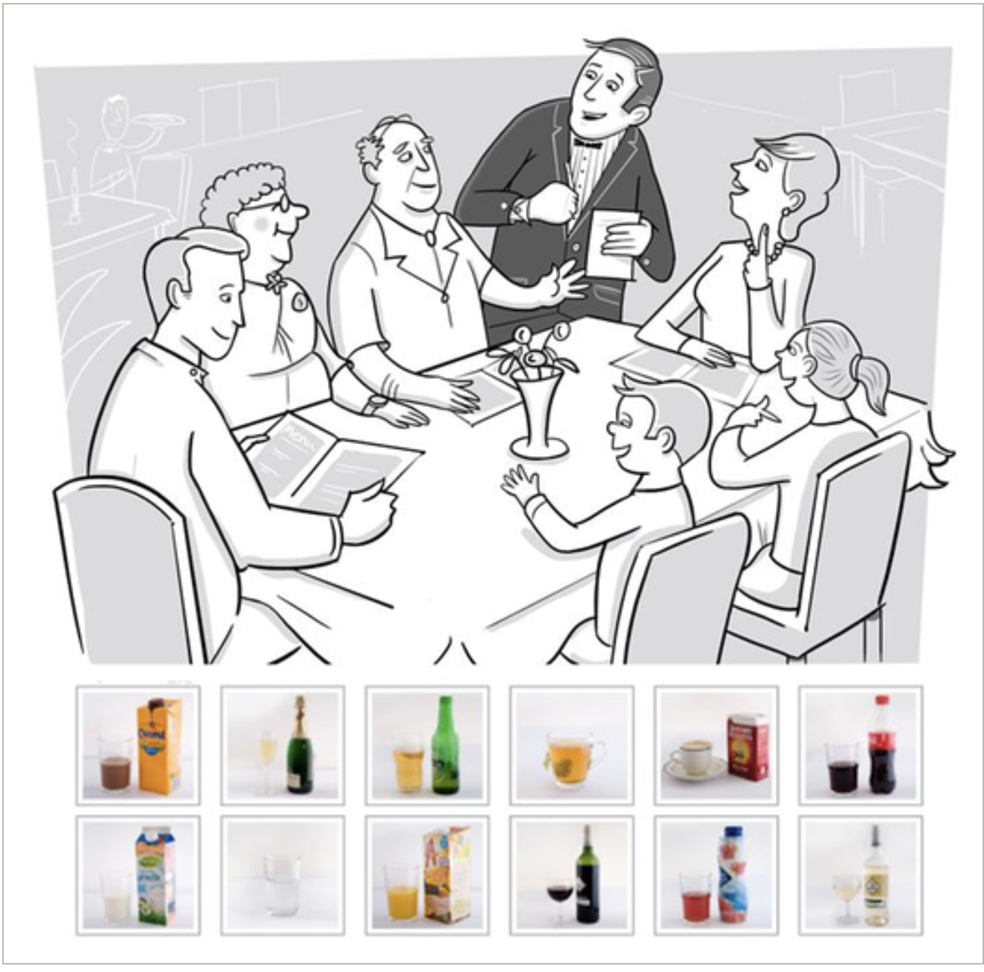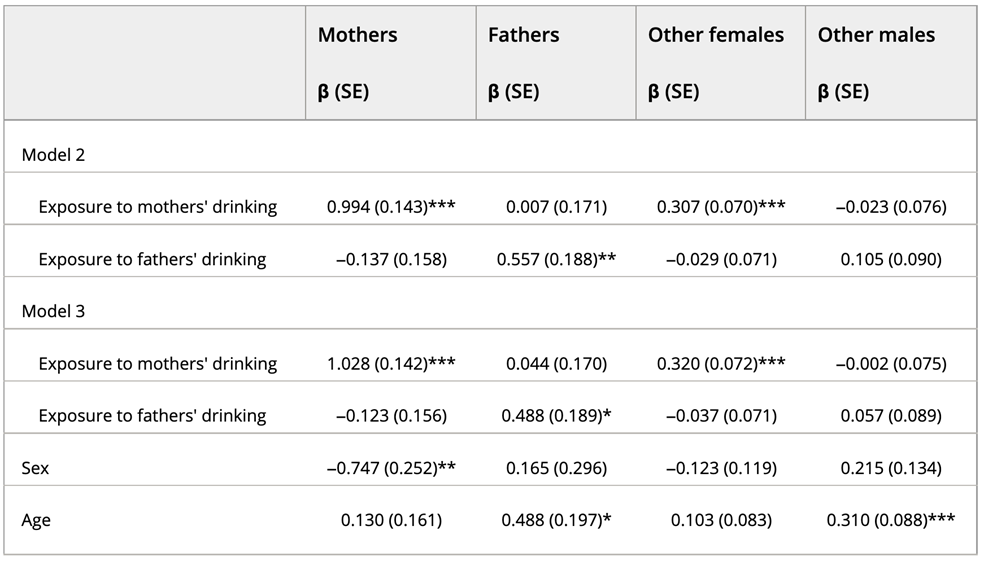Methods
Sample and procedure
Data were drawn from a three-wave multi-informant longitudinal family study including children aged four to six at baseline [Mage 4.78 (SD = 0.725)] and their parents in the Netherlands. The purpose of this family study was to examine precursors of alcohol consumption rooted in childhood (specifically alcohol-related cognitions) and to consider intergenerational transference of these cognitions. Primary schools (n = 831) were contacted in five regions in the Netherlands (Gelderland, Flevoland, Groningen, Zeeland, and Zuid-Holland), with those who agreed to participate (n = 92) asked to distribute letters of invitation to obtain parental consent for first- and second-grade students' participation (more details can be found in Voogt et al., 2017, 2020).
Children (51% girls) completed the Dutch eABT on tablet computers during home visits in 2015, 2016, and 2017 (lasting approximately 40 min). Retention rates were 97.9% (n = 322) at T2 and 97.6% (n = 321) at T3. A majority of participants lived with both their mother and father (92%), most parents reported being married or in a registered partnership (75%) and reported being of Dutch nationality (96% of mothers and 99% of fathers, 98% children).
The task presents children with a range of illustrated situations (see Figure 1 for an example) depicting a range of individuals. Participants are asked to choose one of 12 beverages (four alcoholic and eight nonalcoholic) underneath the illustration to “attribute” to the individual at whom an arrow is pointing; to do so, they tap on the picture of the beverage they think the person in the illustrated situation has been drinking. Illustrated situations are presented one at a time and in a random order. A beverage is attributed to each person in the illustrated situation before moving onto the next situation (answers are stored in a secure database). While adults and children are depicted in the task, the following analysis only includes beverages attributed to the adults, in situations in which it is common to drink (Voogt et al., 2017, 2020).

FIGURE 1
Restaurant situation from the Dutch electronic appropriate beverage task (one of five common illustrated situations depicted). The five common drinking situations were—party, Christmas, restaurant, barbeque, and terrace. The eABT includes four alcoholic (beer, champagne, red wine, and white wine) and eight nonalcoholic beverages (chocolate milk, cola, coffee, lemonade, milk, orange juice, tea, and water)
While children completed the eABT with the assistance of a member of the research team, parents (both mothers and fathers) completed an online survey. There was no time limit on completion, and children were provided with a practice situation (e.g., providing food to farm animals) to familiarize them with the procedure. At the end of each home visit, a small present (e.g., pencil) was provided to the child and one parent received a gift coupon of 10€ as an incentive. Approval was obtained from the Ethical Committee of the Faculty of Social Sciences from Radboud University (ECSW2014-2411-272).
Measures—children's eABT
Persons depicted in the illustrations
Each illustrated situation depicted a range of persons in a situational context (see Figure 1 for an example). Researchers recorded the gender and role of the persons in the illustrations and then grouped the persons for analysis as follows—females (all females depicted), males (all males depicted), mothers, fathers, other females (including female friends and grandmothers), and other males (including male friends and grandfathers). We take the association between the beverage attributed (alcoholic or nonalcoholic) and the person in the illustrated situation as evidence of a child's perception of a normative relationship.
Alcoholic beverages
When completing the task, children were asked to tap on the picture of the beverage that they believed the person in the illustrated situation, as indicated by an arrow, was drinking. These were the children's “attributions.” Given that beverage-specific explorations have been reported previously using this sample (Cook, Kuntsche, Smit, et al., 2021), the focus of this paper is on children's perceptions of who is more likely to drink alcohol overall. Attributions of any of the four alcoholic beverages (of 12 total beverages) to the persons in the illustrated situations were coded into a dichotomous variable indicating alcohol attributions (1) or not (0) at each of the three time points (from which we created an overall mean score—see analytic strategy section for more details).
Participant sex
Participant sex was recorded by the parent/legal guardian, and coded as 0 = boys, 1 = girls.
Age at baseline
Age was recorded at baseline and coded as the subgroups—4, 5, and 6 years.
Measures—parental questionnaire
Parental alcohol use frequency
Parents' alcohol use was assessed using the question: “How often did you drink alcohol in the past four weeks?.” The response categories were recoded into the number of days on which alcohol was consumed per month as 0 = “no consumption in the past four weeks,” 2 = “one to three drinks per month,” 4.25 = “one to two drinks per week,” 14.875 = “three to four drinks per week,” 23.375 = “five to six drinks per week,” and 30 = “drinking every day.”
Exposure to parental alcohol use
Parents responded to a questionnaire on their consumption in nine drinking situations (this ranking was based on previous research with the same sample, Voogt et al., 2020). These situations were dinner, Christmas, party, watching tv, barbeque, terrace restaurant, and camping. The items asked participants how often they drank alcohol in the situations that corresponded to the family-related situations included in the eABT which the children completed. The response categories ranged from 0 = “never” to 4 = “always”. This information was reported by both mothers and fathers. We created a mean score across the nine situations for mothers and fathers separately.
Analytic strategy
Of the 329 children who completed the task, 24 (7.3%) had missing data on the variables of interest from both parents at one or more waves of data collection and four had missing data from both parents at all three waves. Descriptive analysis, including independent samples t-tests and standardized mean effect sizes (Cohen's D), were first conducted in SPSS and are presented in Table 1, then regression analysis was conducted using the Mplus statistical software (Muthén & Muthén, 1998-2020) to examine intergenerational exposure on normative perceptions. Missing data were accounted for using the full-information maximum likelihood option in Mplus. Given we were not interested in changes over time, we created a mean score of the data from the three annual time points (collected 2015, 2016, and 2017, meaning children were between 4- and 8-year-olds).
TABLE 1. Means (SD) of parent's alcohol-related behaviors and children's exposure separate for fathers and mothers

*** p < 0.001.
a Consumption refers to the frequency og consumption in the past 4 weeks.
Three ordinary least-squares (linear) regression models were estimated. In the first model, children's attributions of alcohol to the females and the males depicted in the eABT (this is the mean score across the three time points) were regressed on exposure to mothers and fathers drinking, respectively. This allowed us to examine overall person-specific drinking norms (hypothesis 1). In the second model, we examined whether exposure to mothers drinking was linked to children's attributions of alcohol to the mothers, fathers, other females, and other males depicted in the eABT, and again the same for fathers (hypothesis 2). In the third model, we examined whether the emerging association remained significant when adjusting for children's age and sex.





